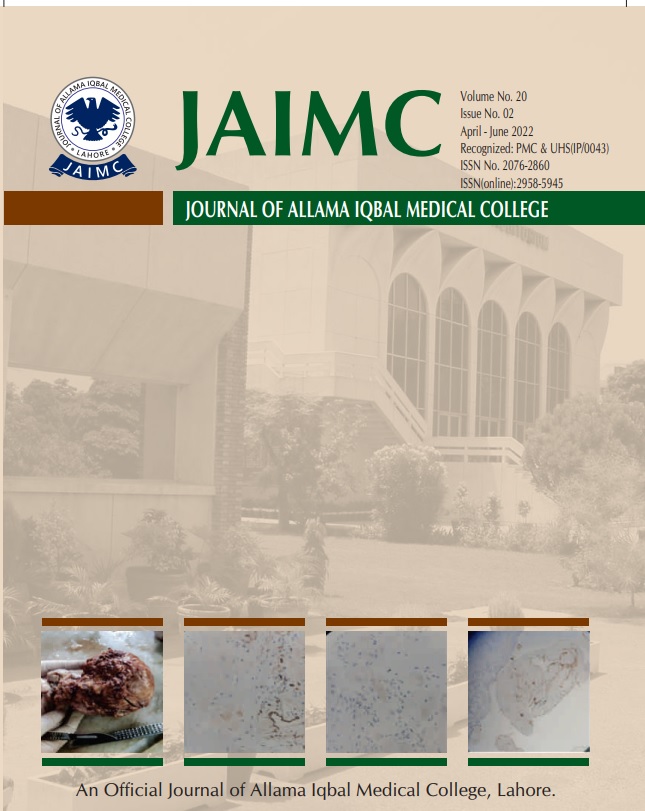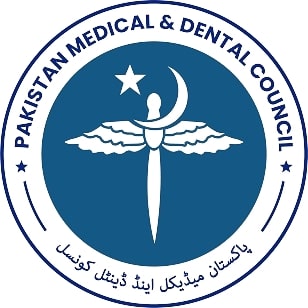SCREENING COLLEGE STUDENTS FOR BODY DYSMORPHIC DISORDER USING DYSMORPHIC CONCERN QUESTIONNAIRE: A CROSS SECTIONAL STUDY COMPARING PUBLIC SECTOR MEDICAL AND NON-MEDICAL STUDENTS IN PUNJAB, PAKISTAN
DOI:
https://doi.org/10.59058/jaimc.v20i2.28Keywords:
Body Dysmorphic Disorder, Medical students, Non-medical students, Depression and suicide, Social pressure, Obsessive-compulsive spectrum disorder, Dysmorphic Concern QuestionnaireAbstract
Background and Objectives: Body Dysmorphic disorder (BDD) is a psychiatric condition characterized by preoccupation with an imagined flaw in appearance or slight defect in one's body. It is a disabling obsessive- compulsive spectrum disorder often goes unrecognized in clinical practice and found to be associated with social anxiety, distress and suicidal tendency. The aim of this study was to screen public sector college students for body dysmorphic disorder using a validated dysmorphic concern questionnaire® through an online survey and describing family, peers and media influences in relation to its occurrence.
Methods: This descriptive, cross-sectional study was undertaken in two public sector medical colleges (Lahore and Sialkot) and one public sector general education college (Sialkot) during November 2019 to June 2022. Overall, 378 students completed a validated 7-items Dysmorphic Concern Questionnaire (DCQ)® online. Participants provided responses on a 4-point scale. They also responded to questions regarding social pressures and media influencing the dysmorphic concern. A BDD score was computed as per method described by Mancuso et al. and participants with score more than 14 were labelled as having BDD. Association between family, peers and media influences with BDD score was analyzed using logistic regression technique in SPSS version 25.®
Results: Of 378 participants, 251 (66%) were medical students and 127 (34%) were general education students. About 1.3% medical students and 5.0 % non-medical students were classified having potential body dysmorphic disorder respectively. Adjusted odds ratio comparing medical and non-medical students for BDD is 4.4 (95% CI: 1.2-15.9; p=0.02) with higher odds of BDD observed for those aged 18-20 years (OR=3.3) and in females (OR=1.1, 95% CI=0.4-2.8; p=0.83).
Conclusion: BDD is comparatively frequent in non-medical female students aged 18-20 years. Family and peer pressure alongside the influences from social, print and electronic media had considerable effect on non- medical students comparatively and may contribute the occurrence of body dysmorphic disorder.
References
American Psychiatric Association. Diagnostic and statistical manual of mental disorder, 4th ed. 1994. American Psychiatric Publishing, Washington, DC.
Schneider SC, Mond J, Turner CM, Hudson JL. Sub- threshold body dysmorphic Disorder in adolescents: Prevalence and impact. Psych Research.2017. S0165- 1781(16)30794-6. http://dx.doi.org/ 10.1016/ j.psychres. 2017.01.085
Georgina Krebs, Fernandez L, Mataix-Cols D. Recent advances in understanding and managing body dys- morphic disorder. Evid Based Mental Health. 2017; 1(1):23-25
Phillips KA. The Broken Mirror: Understanding and treating body dysmorphic disorder. Revised and expanded. New York, NY: Oxford University Press; 2005
Phillips KA, Stein DJ, Rauch SL, et al. Should an obsessive-compulsive spectrum grouping of disorders be included in DSM-V? Depress Anxiety. 2010; 27: 528–55.
Veale D, Miles S, Valiallah N. The effect of self-focused attention and mood on appearance dissatisfaction after mirror-gazing: an experimental study. J Behav Ther Exp Psychiatry. 2016;52:38–44. doi: 10.1016/j.jbtep. 2016.03.002
Taqui AM, Shaikh M, Gowami SA, Shahid E, Khan A, Tayyab SM, et al. Body dysmorphic disorder: gender differences and prevalence in Pakistani medical stu- dents, BMC psychiatry.2008;l9 (2):20-25
Hakim RF, Alrahmani DA, Ahmed DM, Alharthi NA, Fida AR, Al-Raddadi RM. Association of body dy- smorphic disorder with anxiety, depression, and stress among university students. J Taibah Univ Med Sci. 2021;16 (5):689-694. doi:10.1016/j.jtumed. 2021. 05. 008
Weingarten H, Renshaw KD, Wilhelm S, Tangney JP, Di Mauro J. Anxiety and shame as risk factors for depression, suicidality, and functional impairment in body dysmorphic disorder and obsessive compulsive disorder. J Nerv Ment Dis. 2016;204(11):832.
Veale D. Body dysmorphic disorder. Postgrad Med J. 2004; 80:67–71. Doi: 10.1136/pmj.2003.015289
Alghamdi WA, Subki AH, Khatib HA, Butt NS4, Alghamdi RA, Mohammed Alsallum MS. Body Dys- morphic Disorder Symptoms: Prevalence and risk factors in an Arab Middle Eastern population. Int J of Gen Med. 2022; 15: 2905–2912
Angelakis I, Gooding PA, Panagioti M. Suicidality in body dysmorphic disorder (BDD): a systematic review with meta-analysis. Clin Psychol Rev. 2016; 49:55–66. doi:10.1016/j.cpr.2016.08.002
Oosthuizen P, Lambert T, Castle DJ. Dysmorphic concern: prevalence and associations with clinical variables. Australian and New Zealand J Psych. 1998; 32:129-132
Casha TF, Phillips KA, Santos MT, Hrabosky JI. Mea- suring ‘‘negative body image’’: validation of the Body Image Disturbance Questionnaire in a nonclinical population. Body Image 1 (2004) 363–372. doi: 10. 1016/ j.bodyim.2004.10.001
Mancuso SG, Knoesen NP, Castle DJ. The Dysmorphic Concern Questionnaire: A Screening Measure for Body Dysmorphic Disorder.Australian& New Zealand J Psych. 2010; 44(6):535-542. doi: 10.3109/ 0004867 1003596055
Veale D, Matsunaga H. Body dysmorphic disorder and olfactory reference disorder: proposals for ICD-
Rev Bras Psiquiatr 2014;36:(Suppl 1):14–20
Ahamed SS, Enani J, Al Faradi L, Sannari L, Ajgani R, Ajsawah Z, et al. Prevalence of Body dysmorphic disorder and its association with body features in female medical students. Iran J Psychiatry Behay Sci. 2016 May 15:10(2) e3868.
Liao Y, Knoesen NP, Deng Y, Tang J, Castle DJ, Bookun R, et al. Body dysmorphic disorder, social anxiety and depressive symptoms in Chinese medical students. Soc Psychiatry. 2010 ; 45(1D):963-71
Aknarbegloo M, Z Habibpur Z, Motaareli H. Percep- tion of body images in students and related factors. The social sciences. Med well Journals.2010; 5(4): 368-372
Danesh M, Kourosh BS. Beroukhim BS, Nguyen C, Levin E, KOO J. Body Dysmorphic Disorder Scree- ning Tools for the dermatologist: A systematic review. Pract Derm. 2015. 12(1):44-49.
Brohede S, Wingren G, Wijma B, Wijma K. Validation of the Body Dysmorphic Disorder Questionnaire in a community sample of Swedish women. Psychiatry Research. 2013;210;647–652

Downloads
Published
How to Cite
Issue
Section
License
Copyright (c) 2023 JAIMC

This work is licensed under a Creative Commons Attribution 4.0 International License.
The articles published in this journal come under creative commons licence Attribution 4.0 International (CC BY 4.0) which allows to copy and redistribute the material in any medium or format Adapt — remix, transform, and build upon the material for any purpose, even commercially under following terms.
-
Attribution — You must give appropriate credit, provide a link to the license, and indicate if changes were made. You may do so in any reasonable manner, but not in any way that suggests the licensor endorses you or your use.
- No additional restrictions — You may not apply legal terms or technological measures that legally restrict others from doing anything the license permits.
The editorial board of the Journal strives hard for the authenticity and accuracy of the material published in the Journal. However, findings and statements are views of the authors and do not necessarily represent views of the Editorial Board. Many software like (Google Maps, Google Earth, Biorender (free version)) restricts the free distribution of materials prepared using these softwares. Therefore, authors are strongly advised to check the license/copyright information of the software used to prepare maps/images. In case of publication of copyright material, the correction will be published in one of the subsequent issues of the Journal, and the authors will bear the printing cost.









